Cats won't change overnight
Be patient. It will take a long time to help cats break down old ideas about each other and create new ones. Unless you are dealing with a case of redirected aggression, the cats' relationship will definitely not change overnight, it will take weeks and months. But, trust me, all your efforts will be rewarded if you modify the behavior and environment correctly and calmly.
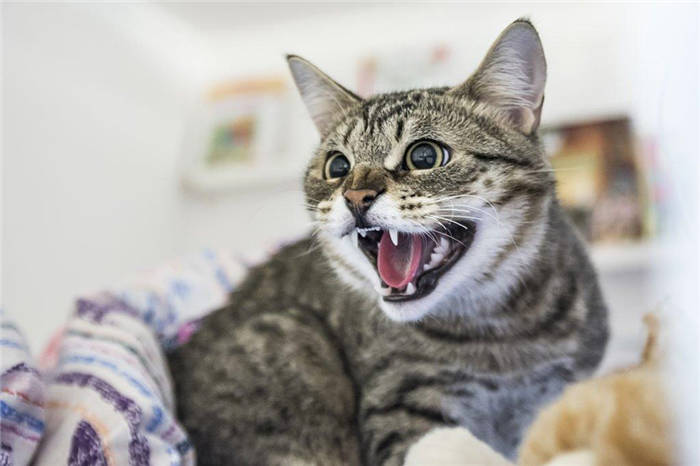
- What to do if the cat attacks the dog?
- Cat hunter and infantile puppy. How do you wean a cat from hunting a puppy?
- Territory defense
- Jealousy
- Cat hissing at the dog: possible causes
- How do you calm a cat?
- Animals are able to negotiate
- Isolation is not a good helper.
- Cats aren't contactable.
- Competition for territory
- Cat fights. What should you do if your cats are attacking each other?
- Has your cat attacked you? Find out why! Reasons for cat aggression directed at the owner
- The character of the cat
- Stress
What to do if the cat attacks the dog?
We are used to facing the opposite problem: most often dogs chase cats. Yet aggression also happens from weaker pets.
Too Different. Dogs and cats are different in nature. The former are social animals, while the latter often prefer solitude. Body language differs between the two species, and dogs are not always successful in reading cat threats. As a result, the cat may attack simply because it is bored with the games of man's best friend, and explaining the fluffy pet in his own language does not help.
What's the danger? A small cat can injure even a large dog. Just one scratch on the eye, for example, and it can lead to a corneal ulcer. Small scratches might get infected, causing the wound to fester. And the dog, if he gets mad with pain, might also hurt the cat.
That's why you must find out the cause and protect your pets from fighting. Let's understand why the cat may attack the dog and what to do in this or that case.
Lack of privacy. Every cat needs its own nook where it can curl up and snooze. If she is pestered while resting, she may get angry and attack. Provide a place for your pet where no other pet can reach – it could be a crate with a hole where only the cat can get in, or a closet house.
Stress . The cat may lash out at the dog because of stress. Consider if there have been any recent changes that may have affected your furry pet. Perhaps you got a dog recently and the cat has not had time to get used to it. Or you have moved to a new home. Illness, sudden temperature changes, repairs – cats are sensitive to even the smallest changes.
The object of the hunt . Some cats have a strong hunting instinct. They like to snoop and attack family members, rush to their feet, and stalk. The targets are often puppies and small dogs. And while in the first case, the cat's behavior is likely to change as the dog grows older, in the second, it is unlikely. Shifting the cat's attention to another game may help here. Make sure your pet has enough favorite toys. Interactive games and catnip can also help, as can attaching a leash to your dog or puppy. Cats are usually distracted from the pet by the leash.
Cat hunter and infantile puppy. How do you wean a cat from hunting a puppy?
Good afternoon everyone!
The question is a bit unusual for this section and I'm not really sure if this is the right place to ask. But maybe someone can help?
About the situation in a nutshell:
My friends took an 8 month old Chinese Crested puppy from me. They have a 1.5 year old cat at home, never kept dogs before. Just yesterday the cat started chasing the puppy.
And now for a more detailed description:
The first day the cat curiously watched the new tenant.
The second day he gently touched him on the butt with his paw, the puppy didn't pay any attention to it. Then the cat touched him on the bottom more forcefully. Then he just kicked him so that the puppy ran away to hide to his mistress.
The third day (was yesterday) the cat has been repeating the "groping" and each time it hits harder and has already begun to jump on the puppy from ambush.
If you lock the puppy in a separate room, the cat goes on a rampage and trash the whole apartment (he did not dig closed doors before). I told him to buy a cage to close the puppy when the owners were gone. But, you know, that's not the answer. At the moment and until October the owner is at home all the time, and in October she has institute, ie, no one home from morning till evening. So the cage, IMHO, is a temporary solution.
Question for people who know the behavior of cats: how to make a puppy not an object of hunting, but at least a roommate?
Territory defense
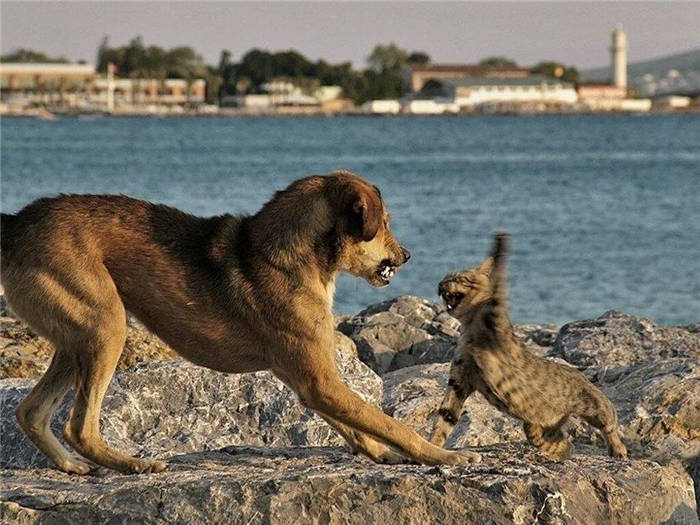
If a cat and a dog have to share a house, conflict is unavoidable. Cats do not tolerate intrusion into their space. They do not like it when guests come, and certainly if dogs come into the house, it is "war". They will stay away from the dog and try to intimidate him. A lot depends on the first introduction, but it also happens that cats and dogs do not find common ground. For the owner, this can turn into endless "headaches" and futile attempts to make friends with stubborn pets. Unhappy owners resort to a lot of tricks: they give them treats and compliments, scold them and even threaten them. But in most cases, cats remain formidable and unwavering guardians of their territory.
Jealousy
Cats are very jealous. They are less attached to their owner than dogs. But they still do not like rivals. In the struggle for the owner's attention, both sides can show aggression. Among dogs, there are also many jealous breeds. For them, it is very painful to share their loved one with someone else. Especially with some cat. On this ground between the pets can arise animosity. And the first to show their discontent can be cats. They will start hissing at the dog and may even scratch. If you own two such unlike pets, try to give them both the attention they deserve. Don't let either one of them feel hurt or left out.
The relationship between cats and dogs is very difficult. Often we have no influence on their confrontation. Even in the sweetest domestic cat can wake up a tigress, when she sees her sworn enemy. Of course, the first impulse of the little predator will be self-defense. The hissing is a warning of a possible attack. It is important for the cat to be safe, and in this way it protects itself. It is unlikely that the owner can fundamentally change the situation. After all, the feud between cats and dogs has been going on for centuries.
Cat hissing at the dog: possible causes
Cat hissing is one of the signals of communication. With this sound, the animal alerts that it is uncomfortable due to stress or pain. The hissing is an emotional manifestation of the cat's internal malaise. More often than not, it is a warning signal or a defense option.
- Aggression and preparation for an attack. Before the start of "pawing" the cat tries to frighten the opponent with a hiss. This is a signal that an attack is imminent. The dog may remain cheerful and happily wag its tail.
- The dog is an object of irritation for the cat. Mobility, activity, barking or howling of the dog, the desire to play bring discomfort and even pain to the whiskers. The hissing in this case is a menacing sound, which means that the cat requires peace and quiet.
- Fear. A cat hisses and adopts a fighting stance: its whiskers and fur are ruffled, the animal visually seems larger. Fear is also connected with the sense of danger. The cat wants to defend itself and show that it can fight back. A hissing at a dog is a warning of the danger coming from it.
- Memorable offense. If a cat has previously been frightened by dogs (chased into a tree, attacked and barked, bitten), then it will see all other representatives of this species as a danger or will seek revenge. As a consequence, the dog hisses menacingly, and prepares to fight and take revenge.
- Stress caused by competition and jealousy. The cat becomes fearful, irritable and will react negatively even to petting. May begin to tag corners or scratch furniture. It reacts negatively and aggressively to dogs and sees them as an enemy and competitor. Cats are independent and willful creatures, they take hard the presence of a competitor in their territory.
- Guarding the food bowl. A cat hisses at a dog if it approaches its bowl. In addition to hissing, whiskers can meow hostilely, hit a competitor with their paw, and throw themselves into a fight (specific actions depend on the nature of the cat).
How do you calm a cat?
If a cat hisses at a new animal in the house, give it time to get used to it and to the idea that it is no longer alone. Until then, make sure that there are no fights or altercations between the pets. If the cat took a fighting position and began to hiss menacingly, touching it is strictly prohibited. Such actions will scare the whisker even more, and this threatens aggression on its part: clawing, biting. The cat should calm down on its own, after realizing that it is not in danger. With regular and excessive expression of aggression on the dog, it is recommended to show the cat to the veterinarian. In some cases, special sedatives (Stop-Stress, Fitex, Cot Bayun and similar) are prescribed for fluffy dogs.
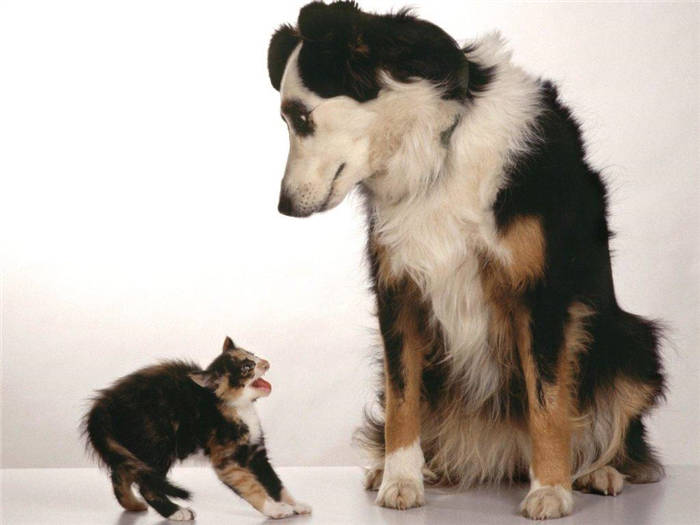
Algorithm of action for the owner, if the hissing repeats once or rarely.
- Exclude the irritant. The dog should be taken to another room (separate opponents). It is allowed only if the dog is calm, does not growl and does not show aggression towards the cat. If the dog and the cat are in fighting positions, you may not touch them.
- Shift attention and distract the pet. It is best to throw the cat any object that makes a sound (a rattle, a bunch of keys, a keychain, a toy). As a last resort, you can offer the furious fluffy cat a treat, but you can't do it often, because the cat will get used to it and will hiss and demand delicious food.
- The effect of surprise. A proven remedy is a sprayer of water aimed at the cat's face. This action is designed to inhibit an attack. It is suitable for dogs and cats. A cascade of spray will stop and distract the animals. During this time, you can take them to different rooms and calm them down.
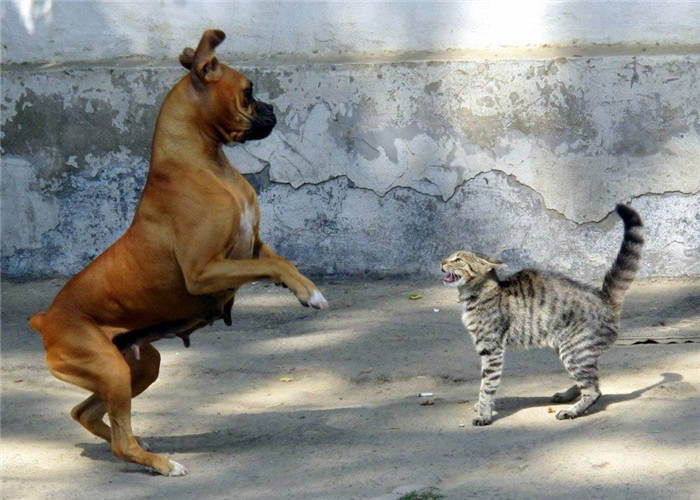
So, hissing is a natural communication signal for cats. It's how fluffy cats communicate that they are uncomfortable or in pain. A cat can hiss at a dog for many reasons: fear and aggression, danger and resentment, jealousy and competition. Touching, petting and caressing an angry animal is forbidden. If the hissing is rare, there is no reason to worry – it is a sign of animosity between two animals. But if the fights are repeated every day, you need to take action.
Animals are able to negotiate
The need to help animals to agree is very rare. Most often it concerns either cases of irreconcilable enmity or, as in the situation described above, serious differences in temperament. The worst case scenario occurs when an active dog that has lived outside for a long time comes into the house. Most likely, it had to get its own food and, naturally, cats are seen as prey in this case.
It is impossible to give advice on overcoming irreconcilable enmity in absentia: To overcome serious difficulties in a relationship, you need to understand the causes of their occurrence and see the prospects. This requires personal communication, so the only sensible advice is to make an appointment with a specialist.
If it is only a matter of the difference in temperament between the cat and the dog, it is usually much easier to solve the problem. Gentle and calm human actions will help the animals to understand each other and improve the relationship.
Most often the tension in the house grows because of the dog's behavior: not knowing the rules and not having the necessary communication skills, the active little puppy obsessively calls the cat to play. This causes considerable discomfort to the cat, and it, in turn, expresses its displeasure at what is happening in every way possible. She is understandable, because who likes to look around all the time before getting down on the floor or going to the toilet.
The main tasks, as it seems to me, are two. The first: To explain to the puppy that the cat is not an object of prey. The second: Let the cat and the dog get used to each other.
Isolation is not a good helper.
Now watch out: you're going to have to exert yourself and take risks. The expression "getting out of your comfort zone" is very popular now, and it captures the essence of what's going on as accurately as possible. To work on a problem, you have to see it. To see a problem, you have to create it. In other words, you can't accustom a cat and a dog to each other's company if they don't meet.
You can't accustom a cat and a dog to each other's company if they don't meet. Photo jakpost.travel
It will take patience and lots of bits and pieces to be successful. Not just any abstract bits, like meat slices in sachets with descriptions of their wonderful properties, but pieces that will make puppy lose his head and forget everything. Sausage and cheese are beyond competition, always.
It's clear that first you have to let the cat and the dog sniff in a safe environment. It's very good, if the cat is more or less adult and relatively tame: sometimes you come across such specimens, that it's scary to approach them, but that's another story.
Have plenty of goodies, so that they won't run out when you need them, and put them in a way that makes it easy to take them and give them to the puppy.
Cats aren't contactable.
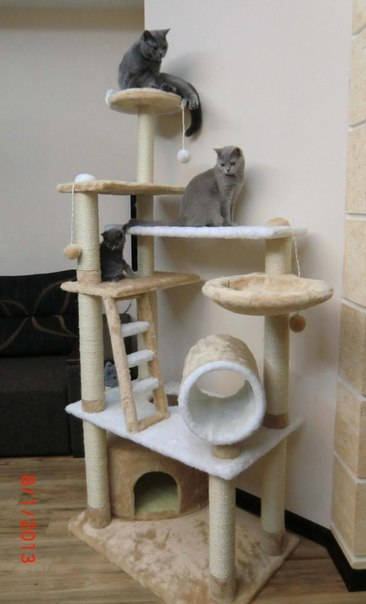
The second theory is that it is cats that don't like dogs. While dogs often huddle together in packs, cats, on the other hand, prefer to lead a solitary lifestyle. This is due to the fact that members of the feline family, for the most part, do not like contact with other individuals. If a cat is hostile to its relatives, what can be said about relations with representatives of other species. Often a dog's attack on a cat is a simple curiosity or a response to provocation.
Competition for territory
The third version is related to competition for territory. Each animal claims a certain place, which it considers its own. If these spatial segments in two individuals overlap, they will start fighting each other for territory. Cats' territorial claims are usually stronger, because cats are attached to their homes, while dogs are attached to their families.
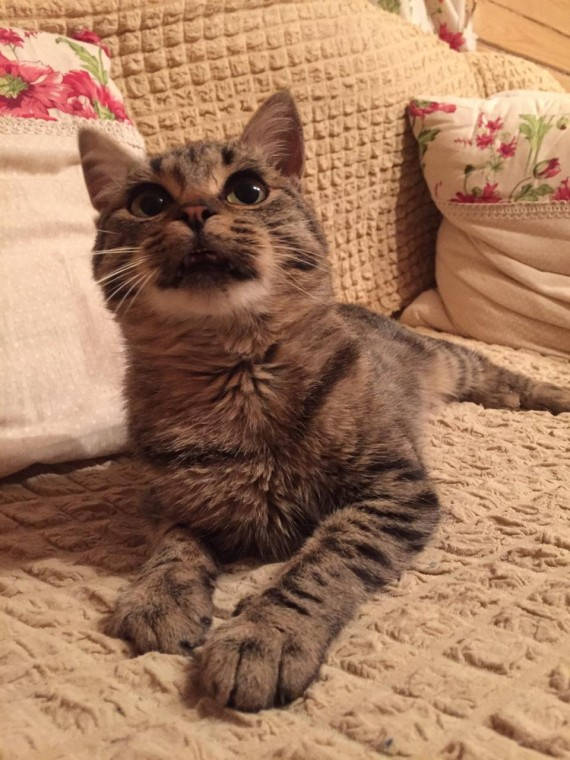
The fourth version is related to the different structure of the organisms. There is a theory that members of the feline family produce some special enzyme that negatively affects the subconscious of dogs, making them aggressive and agitated. This theory could explain everything, but it collapses due to the fact that many cats and dogs are friends and even spend most of their time together without any discomfort.
Cat fights. What should you do if your cats are attacking each other?
Unpleasant and frightening for owners are cases when two cats living under one roof decide to have a fight for spheres of influence. It is possible that before that they lived in relative peace, or maybe they never had a good relationship at all, in any case their behavior was getting worse and worse from day to day. It is even possible that everything changed in one day, when the owner returned from work to find the cats growling menacingly in the living room and scraps of hair scattered all over the apartment. Of course, the owners are very upset by this behavior of their pets, because they do not want their apartment to become a battlefield. Often the aggressive behavior of cats directed at each other drags on for months or even years. Owners do not know how to deal with it, and do not suspect that the cause of this behavior may be a number of reasons that they have the power to eliminate.
Aggression between cats
I often notice that many owners don't always acknowledge the fact that their cats don't get along with each other because they don't see clear signs of aggression between them. Such owners' cats don't tear each other's hair out in fierce battles, they don't yell or hiss, so no one notices the subtle signs of aggression that exist between them. After all, aggression can be not only visible – physical, but also difficult to recognize – psychological. But the worst thing is that it is the psychological aggression that is the most frightening – eventually it will develop into physical aggression, but until then it keeps cats under constant stress. The cat is under constant psychological pressure – and you may not even notice it.
Keep in mind that cats prefer not to engage in a real physical confrontation, and so they will try to disarm their opponent with psychological pressure (intimidation). Every cat hopes that when he fluffs up his fur, grunts softly, or even grinds his teeth in a hiss, he will convey to his opponent, "I'm a really scary guy, so don't mess with me!" and convince his opponent to back off. This kind of intimidation is something you and I will notice and know that something is wrong. But there are many other methods of covert intimidation, such as guarding the path to the litter box, guarding the path to bowls of food or water, or, for example, such harmless things at first sight, as when one cat carefully sniffs another cat while it is eating from a bowl.
Has your cat attacked you? Find out why! Reasons for cat aggression directed at the owner
The most dramatic cases in my practice always involve aggression by a cat directed at its owners. If conflicts between several cats or between a cat and a dog can be tolerated for years by the owners, separating the animals in space and time, then an attack on a child or grandmother, or on the breadwinner and head of the family, can be tolerated by few. The more so that often, attacks of cats on their owners are not limited to a single case. The reason is that the owners do not react to the conflict correctly or do not have the ability to react properly, and in the cat's head, the so-called "survival mode" is started in response to the owners. In this mode, the cat is at the peak of its emotions all the time, and any careless action of the owners causes a new attack of aggression.
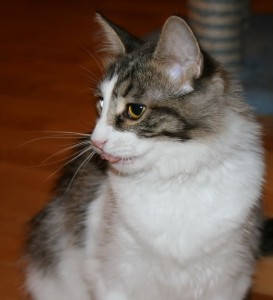
But you have to understand that cats do not attack for no reason! Any cat behavior has a tangible reason and it can be found and eliminated. Yes, there are occasional intractable causes, most often health-related, but most of them can also be controlled with medication.
The most common reason for a cat to attack its owners is redirected aggression caused by pain or ill health. When a cat feels a sharp pain it doesn't think "Oh, my stomach is upset, I shouldn't have eaten sausage peels from the garbage", moreover the cat doesn't even know that it has some internal organs that can hurt. A cat that suddenly feels pain (whether the pain impulse comes from inside or outside the body) instantly triggers an innate instinct – "hit or run". This is due to the fact that in nature a cat has many enemies, and suddenly another cat or predator can hurt it, and it is necessary to react quickly and clearly to save your life. If the cat is going to figure out who it is that grabbed its butt with its teeth, it will be eaten quickly. Therefore, an attack or an attempt to escape happens automatically and lightning-fast, without the cat's mind being involved. So, if a cat feels a sharp pain, it will attack the first person in sight. For example, on the owner. After the master fights with the cat trying to save his limbs, the cat's subcortex makes him an enemy and this is the reason of repeated attacks.
The character of the cat
Many cats have a very strong character that does not allow them to live in perfect symbiosis with other animals. If a cat wants to dominate and senses an easy prey in a dog, she will certainly decide to take advantage of it. She will suppress the dog until he completely submits to her. Obviously, this hurts the dog, in the worst case, it can lead to open conflict and aggressive behavior on both sides.
Don't forget that cats have a strong hunting instinct, and they have to find a way to satisfy it. A rubber mouse is not always enough for them. It may happen that the cat will find its prey in a smaller dog – especially in a puppy. In this case you should be very careful, because the cat's hunt can end painfully for the dog.
Stress
In cats, as in humans or dogs, aggression may be a natural reaction to fear and stress. This is how a cat reacts to possible (or perceived) danger. Especially if it cannot avoid it (run away from it). It feels threatened by the dog, so it goes on the offensive to signal immediately: stay away from me, or else it will be bad. If the dog doesn't stay away, the conflict is ready. That's why we never put up with this kind of behavior and introduce simple rules in the house, so that the animals at least tolerate each other.
If you have a similar situation and can't handle the conflict, get help from an animal behaviorist!






